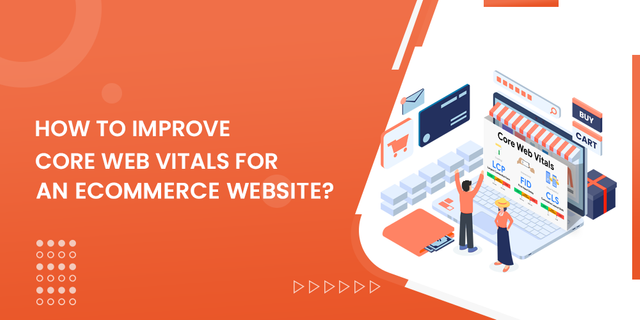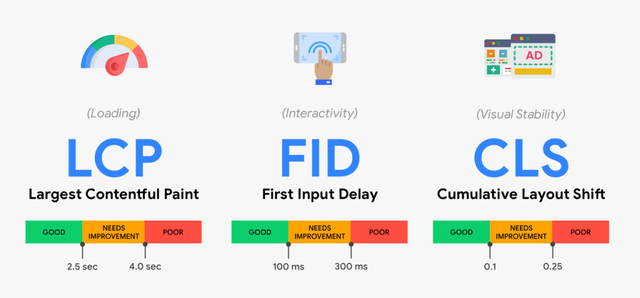
Google’s next Page Experience update will incorporate Core Web Vitals (CWV) signals into the official ranking algorithm. Core Web Vitals is a series of measurements that evaluate how fast web pages load and become interactive and aesthetically stable for real users. When it comes to your eCommerce website, it is essential to ensure that all of your critical online vitals are operational. To achieve that, you should learn what vital web lives are and how they may help you – and how you can increase metrics on your website if they already do not perform correctly.
What Are The Core Web Vitals?
Google takes into account many indicators or metrics that can be used to assess the performance of websites. The measurements are used to analyze the website’s speed, reactivity, and visual stability. All three elements, when combined, can improve the website’s User Experience and Web Performance, and thus these elements are collectively known as the Core Web Vitals. The three significant metrics that comprise the Core Web Vitals are as follows:

1. LCP Or Largest Contentful Paint
The Largest Contentful Paint or LCP can be defined as the time or the duration of time that is generally taken up for loading the contents of a page. Generally, to consider, 2.5 seconds or less is the optimal time limit. The website must improve if the time is between 2.5 and 4 seconds, and anything less than 4 seconds is deemed bad performance. This would bore out the users, and they would ultimately leave the page.
2. First Input Delay-FID Or LID
The time it takes for a webpage to become interactive is called First Input Delay or LID. The interaction time a webpage takes and the suggested time limit is 100 milliseconds. Improvement is necessary between 100 and 300 milliseconds, while performance below 300 milliseconds is regarded as unsatisfactory.
3. Cumulative Layout Shift Or CLS
The unexpected shift in a webpage’s visual layout shift should preferably be less than 0.1. If it’s higher than 2.5, the site needs to be improved.According to Google, these are the essential health indicators for a website, and thus, one of the fundamental ones. Website owners can use these metrics to assess their site’s performance and make improvements easily.
How Vital Is Core Web Vitals?
Google wants to make these essentials a vital ranking criterion for websites. It aspires to make these indicators indispensable in determining organic rankings for websites.
If you run a business, you might not find Google’s algorithm interesting enough to learn about. On the other hand, understanding the vitals will make a lot of sense if you own an internet business, a website, or a SaaS company.
That’s because you’re curious about how the new ranking methodology will affect the performance of your website. Along with these essentials, mobile-friendliness and website page performance are also important considerations.
The reality is that if you fall behind and do not upgrade your site to meet the new criteria, your rankings will suffer, and your competitors will rise to fill the void. As a result, providing visitors with a top-notch user experience is critical.
In other words, keep your website healthy if you want to be part of the organic ranks. It is reasonable to assume that the core crucial will account for most of the page experience or user experience.
How Do We Measure Core Web Vitals And Enhance Them?
For most users, the Google tools package is sufficient to measure the core web vital, whether they are minor or massive. Chrome User Experience Report collects anonymized user measurement data on essential subjects (Chrome UX Report/CrUX). This data correctly measures the performance of the site using Core Web Vital reports and PageSpeed Insights.
Taking a brief look at this:
Use the new Core Web Vitals Report to find pages requiring attention in the Search Console.
Use Chrome UX Report and Lighthouse-enabled PageSpeed Insights or PSI to find out where the problem is on the page once you have successfully identified the pages that need to be repaired. PSI is accessible via the Google Search Console. Users may also use PSI to enter URLs.
Use Chrome DevTools or Lighthouse to measure Core Web Vitals and get recommendations on fixing issues. The Web Vitals Chrome plugin allows you to observe the desktop in real-time.
Use the CrUX Dashboard or the newest Chrome UX Report API if you need a specific Core Web Vitals dashboard. To access lab data, you may also use the PSI API.
The web.dev can also be used to track page performance. It guides you through the process by showing a series of code labs that can optimize using PSI data.
How To Enhance Web Core Vitals?
LCP or Largest Contentful Paint: LCP differs from other page speed indicators because it helps to identify the essential aspects affecting page speed.
As a result, it refers to the visibility and interaction quotient of your website. The LCP speed score can be used with PSI. It is based on real user behavior because of Chrome’s statistics.
On the other hand, the limitation of PSI is that it can only review one page at a time. Google Search Console is valid for a broad website overview.
Read full article from source URL: How To Improve Core Web Vitals For An Ecommerce Website?